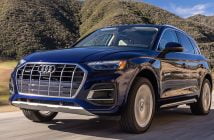+++ Volkswagen is tweaking its partnerships in China, paving the way to migrate some production of the popular AUDI brand out of its joint venture with the decrepit China FAW and into the more dynamic SAIC. FAW may mourn, but the Audi team is most worried about Mercedes Benz, not its local partners. After 3 decades of policy coddling, Chinese domestic Joint Venture brands are still not competing at the Germans’ level. The Chinese market has provided a precious cushion for Volkswagen as it recovers from damage done by an emissions scandal that began in the United States in 2015. Volkswagen delivered nearly 3 million passenger cars to Chinese customers in the first 3 quarters of 2016, a rise of over 10 percent and nearly 40 percent of the company’s worldwide total. Audis make up a fair portion of the profit from those sales, thanks to early entry into China and a position as the country’s dominant luxury brand. On the face of it, this might make Volkswagen wary about snubbing FAW, a state-owned giant launched in 1956 with Soviet assistance. Not so. The Wolfsburg-based group’s move to get closer to SAIC makes business sense. Its partner already makes Volkswagen vehicles and it’s China’s largest automaker by volume with nearly $80 billion in revenue in the first 3 quarters. SAIC is far better placed to fight off encroachments from foreign luxury brands than FAW, struggling with the fallout of a corruption investigation. Better yet, SAIC is no threat. Beijing requires foreign carmakers to form joint ventures, originally part of a plan to transfer technology to build global Chinese competitors. That didn’t happen. Official data show China only exported around 320,000 passenger cars in the first 9 months of 2016. Meanwhile brand development efforts for domestic models still look like afterthoughts. SAIC’s upscale Roewe brand, for example, sounds like “wrong way” pronounced in Chinese. Then there are Guangzhou Auto’s Trumpchi, Dongfeng Motor’s EQ7240BP, and the Geely PU Rural Nanny. Easy Joint Venture profits have not noticeably been reinvested in developing international marketing savvy. Geely, however, is learning. That may be because rather than joint-venturing, it acquired Volvo from Ford in 2010. Geely turned the Swedish brand around, and is now launching a “Lynk&Co” brand in international markets. Geely has escaped the partnership trap. For its Chinese peers, policies designed to produce domestic champions have instead numbed them with easy profit. +++
+++ FORD is moving ahead with plans to shift production of small cars to Mexico from Michigan, while “two very important products” will be built in its U.S. factories, Chief Executive Officer Mark Fields told. President-elect Donald Trump has criticized Ford for the decision to shift production of the Focus to Mexico in 2018, and said he would consider levying tariffs on Mexican-made Fords. Trump has also said he wants to scrap the North American Free Trade agreement, which also includes Canada, and to build a wall on the U.S.-Mexico border to stop undocumented immigrants. “We’re going forward with our plan to move production of the Focus to Mexico, and importantly that’s to make room for two very important products we’ll be putting back into Michigan plants”, Fields said in an interview on the sidelines of the Los Angeles Auto Show. “There will be no job impact whatsoever with this move”. Ford Chairman Bill Ford Jr. said last month he met with Trump. Ford has countered Trump’s criticism, saying the company, founded by his great-grandfather, makes more cars and trucks in the United States than any other automaker. Fields said with U.S. gasoline prices so low, “it’s very difficult for us to be able to make money on a vehicle produced in the U.S.” in the small car segment. If Ford decided to build the Focus small car line in the United States, and had to raise the price, “we wouldn’t sell the vehicle.” The group that represents Ford and other major automakers in the U.S. has asked the Trump transition team to review and consider easing the Obama administration’s fuel economy standards, which call for automakers to more than double the fuel efficiency of their fleets to 54.5 miles per gallon by 2025. Fuel economy and trade “are two separate issues,” Fields said. Ford also is moving ahead with plans to use factory capacity in other markets to fill gaps in its U.S. lineup. Company executives used the auto show to promote the EcoSport that the company plans to ship from India. “We already have the plants and investment in other parts of the world. It frees us up to make further investments in the U.S.,” Fields said, pointing to the money invested to launch a new SuperDuty pickup at a plant in Kentucky. Ford has cautioned investors that it sees demand for cars and light trucks hitting a plateau in the United States. Fields said heading into the last two months of the year “we are seeing a tougher pricing environment. We expect the industry to be about the same as it was last year, probably a little lower on the retail side, and a continuing competitive pricing environment”, Fields said. +++
+++ JAGUAR Land Rover’s technical design director Wolfgang Ziebart has dismissed hydrogen powered fuel cell vehicles as a “complete nonsense”. Ziebart, who was appointed by Jaguar Land Rover boss Ralf Speth in 2013 to orchestrate the development of the company’s I-Pace battery electric vehicle, said hydrogen did not make sense as a fuel for electric vehicles due to its inherent poor efficiency. “The well to wheel relationship from the energy source to the vehicle is a disaster”, he said. The process of producing the hydrogen and then compressing and cooling it for use in a fuel cell vehicle uses a great deal of energy. “You end up with a well to wheel efficiency of roughly 30% for hydrogen, as opposed to more or less well to wheel 70% efficiency for a battery electric vehicle”, explained Ziebart. “So the efficiency of putting the electric energy directly into a battery is about twice as high as the efficiency of producing and using hydrogen. Also, you have to consider the fact that the battery itself has a high efficiency of around 90% or so. This is the most important argument. The other stuff – for example, the infrastructure for hydrogen fuel cell refuelling not being developed yet – that can be overcome. If there was a strong reason to have a hydrogen infrastructure, then I think it would be set up, but with this disastrous well-to-wheel relationship, it doesn’t just make sense”. Ziebart conceded that hydrogen production “makes some sense if you just want to get rid of energy”. This is particularly applicable in Germany, which often ends up with a power surplus in the electricity grid because it has a lot of coal power plants that cannot be easily adjusted to control the energy production. “In Germany we have a so-called ‘power to gas’ (P2G) initiative as the German electric grid is very inflexible”, he said. The P2G initiative converts excess electrical energy into hydrogen gas. A recent study by scientists at Stanford University and the Technical University of Munich, published in the journal Energy, concluded that battery electric vehicles offer a more affordable way to reduce carbon dioxide emissions than cars powered by hydrogen. The study cited lower costs and higher energy efficiency as the key reasons why it recommended Battery Equiped Vehicles. +++
+++ MAZDA will introduce a number of diesel models into the United States next year. Sources claim that the automaker will soon offer two diesels to U.S. customers and hopes to sell about 50,000 units annually. Mazda’s decision comes after a lengthy process to fine-tune the engines to meet environmental regulations in the United States and despite other brands backing away from offering diesels in the U.S. Initially, a diesel variant of the all-new 2017 CX-5 that was revealed today at the LA Auto Show will be introduced to the US market, and soon after, a diesel Mazda6 will hit dealers as well. Both cars are believed to feature the brand’s SkyActiv-D 2.2-liter four-cylinder oil burner. It is reported that Mazda still sees demand for diesel vehicles in the U.S. and that it will detail the plan at this week’s Los Angeles Auto Show. +++
+++ MCLAREN has confirmed it will launch a three-seater inspired by the original F1 that will bring hybrid power to the company’s line-up for the first time since the P1. The new model is being billed as a ‘hyper-GT’ rather than a hypercar in the mould of the original F1 and its P1 successor. According to McLaren, this means it is “a car designed for long journeys but with the high levels of performance and driver engagement expected of any McLaren”.
Just 106 examples will be built, the same number as the original F1, and each has already been sold. Codenamed BP23, the model is the work of the McLaren Special Operations (MSO) division, headed by ex-Caterham and Zenos boss Ansar Ali. The ‘BP2’ in the codename signifies that this is the second bespoke product to come from MSO and the ‘3’ refers to its three seats. McLaren has revealed a sole image of the model, an abstract bird’s-eye preview sketch. Look closely at it and it reveals the car’s most significant feature: a threeseat layout, with a central driving position and a seat on each side of it, just like the F1. Owners have been told that the model will be produced as a coupé only, with no open-top or track-focused GTR variants planned. This is in keeping with McLaren’s brief to make a hyper-GT. The firm reckons a fixed roof is most befitting of the ultimate grand tourer. McLaren has given little away about the as yet unnamed model’s powertrain, save for the fact that it is a hybrid. It has also revealed that the car will be one of the most powerful McLarens yet produced. As with all McLarens, a version of the twin-turbo 3.8-litre V8 engine will be at its heart, but this time it will be hooked up to an electric motor and battery pack, as with the P1. The fact that its power output is described as ‘one of’ the largest yet seen suggests it will not top the 915 hp of the P1 but will exceed the 675 hp of the 675LT. Insiders previously mentioned a figure far greater than 700 hp. McLaren’s Track22 business plan, announced in March by company boss Mike Flewitt, confirmed more hybrid models as part of the 15 new cars — both regular production and limited run — it plans to launch by 2022, of which this F1 homage is one. The car recognises and promotes the increasing influence of the MSO division, which offers McLaren owners anything from individual paint finishes and trims to fullblown one-off creations. It has created one bespoke product before: the one-off X-1 of 2012. This new F1 homage will showcase MSO’s ability to develop its own models, with insiders promising a “streamlined” exterior “shrink-wrapped in a carbonfibre body of great elegance” and an exquisitely finished interior with bespoke switchgear. Each of the 106 owners will work with MSO to create bespoke colour, trim and personalisation combinations for their individual cars. McLaren has given little away about the styling of the car, but it has revealed that its dihedral doors, a feature of all McLaren Automotive models to date, will be powered for the first time and extend into the roof, as on the F1. Sources have revealed that there will be other nods to the F1 in the styling, with a roof-mounted air scoop among the features. Performance will be explosive, but McLaren will also focus on making the F1 homage its most refined car yet. A McLaren statement read: “The car will deliver the highest levels of refinement, enabling significant journeys to be undertaken with up to three people aboard”. McLaren has not yet confirmed pricing, but sources have indicated that the new car will cost around £2 million when it arrives in early 2019. +++
+++ MINI has just unveiled its 2017 Mini John Cooper Works Rally, set to compete next year in a number of long-distance rallies starting with the famed Dakar. The vehicle is based around the Countryman and has been co-developed by Mini alongside its motorsport partner X-raid and is a completely new racing car compared to the outgoing model. Alongside the Dakar, it aims to complete in the Silk Way Rally in 2017. Powering the Mini John Cooper Works Rally is a turbocharged 3.0-liter six-cylinder diesel engine from BMW modified to offer up 340 hp at 3,250 rpm and most impressively, 800 Nm of torque at 1,850 rpm. Mini says that the powertrain has been optimized by a new engine management system to reduce fuel consumption while still retaining its power at high altitude. Alongside the engine, the racer includes a six-speed gearbox from Sadev, an AP Racing clutch, lockable and oil-cooled front and rear differentials with a Sadev centrifugal diff. There’s also an exhaust system from Akrapovic. Hours upon hours have also been spent on honing the exterior to reduce air resistant and to make the car as aerodynamic as possible. It therefore retains the same dimensions as the previous rally car but includes some tweaks to reduce fuel consumption and provide enhanced cooling. Some of these upgrades include a larger roof-integrated air intake and a honeycomb structure of carbon fiber and Kevlar on the underside of the vehicle. The underside also includes three spare wheels and two hydraulic lifts which can be operated from the cockpit. On the suspension side of things, the new Mini John Cooper Works Rally has been fitted with a system from Reiger Racing Suspension which incorporates two fully adjustable dampers on each wheel with a maximum travel of 250 mm each. There’s also six-piston brake calipers clamping down on ventilated, 320 mm steel discs. According to senior vice president of Mini, Sebastian Mackensen, “Mini and X-raid, which is a legendary partnership. Together we have characterized the successful racing history of this famous British brand with four successive victories in the Dakar and the FIA Cross-Country World Cup from 2012 to 2015. Our desire is to work further in this direction and underline the authentic racing competence of John Cooper Works. With the completion of the new Mini John Cooper Works Rally, Mini is perfectly positioned to expand its sporting successes”. +++
+++ RENAULT Sport is celebrating its 40th birthday in 2016, and to mark the occasion the company revealed a new concept car designed to be the fastest Renault road car yet. The car was called the Clio R.S. 16, and there were many hints at a production version – but now the plans have been scrapped. A Renaultsport spokesperson told: “The Clio R.S. is built at the Alpine Dieppe plant. Here it’s possible to make very low volume, hand built production cars (it’s where we made Clio V6, Spider and, currently, some competition cars – Clio Cup, Formula Renault etc). The plant is also gearing up for the production of the Alpine and, it’s due to the focus on this, the eventual decision was made not to divert attention away to make some R.S.16s. The option of delaying the R.S.16 until after the start-up of Alpine was considered but this would have meant the first-half of 2018, too long for customers to wait. The plant is also gearing up for the production of the Alpine and, it’s due to the focus on this, the eventual decision was made not to divert attention away to make some R.S.16s. The option of delaying the R.S.16 until after the start-up of Alpine was considered but this would have meant the first-half of 2018, too long for customers to wait”. The idea for the Renault Clio R.S. 16 was simple: take the engine and gearbox from a Megane Renaultsport 275 Trophy-R and fit it into the Clio’s body for the ultimate combination of low weight, compact size and high power. The R.S. 16 was named after the current Renault Formula 1 car, and shares its livery too – celebrating the brand’s return to F1 racing in 2016. The project was in development for just 5 months, with the deadline set for the 2016 Monaco Grand Prix, where it was first unveiled, as the car is meant to provide a tangible link between Renaultsport’s F1 efforts and its road cars. +++
+++ The forthcoming SKODA Kodiaq coupe could be sold in Europe after all, according to the firm’s boss Bernhard Maier. The car, which is already under development but which is yet to be revealed, was originally planned for sale in China only, with insiders expressing fears that the upmarket model would undermine Skoda’s reputation for a focus on good value if sold in Europe. However, positive reaction to the standard Skoda Kodiaq, plus a shift to build stronger brand awareness of Skoda, has prompted a rethink, with Maier pushing to have a solution in place by spring 2017. “The good news is that the markets are asking for it”, said Maier. “The difficulty is getting enough production capacity to meet demand – our factory in the Czech Republic is already running 24 hours a day six days a week. It is a very complex question”. Maier added that he was considering all possibilities for increasing production, including potentially manufacturing the car in China for export elsewhere. “The issue then is the transport, logistics and tariff costs – it is not a simple solution”, he said. Maier also reaffirmed that Kodiaq vRS versions are in the pipeline. “Technically it is possible, but we are still building the business case”, he said. “If we can make the case for profitable cars, then why not?” It is likely that both petrol and diesel Kodiaq vRS models would be offered, linked to four-wheel drive systems and producing around 300 hp. +++
+++ Diesel-powered vehicles could end up costing double the price of those with hybrid powertrains in the future, the boss of TOYOTA ’s powertrain division has predicted. As increasingly stringent emissions regulations force car manufacturers to equip their diesel-powered cars with traps and aftertreatments to reduce the amount of particulates emitted from the exhaust, these costly systems will drive up the cost of cars. Traditionally diesel-powered cars have cost more than petrol variants, but less than hybrids. Koei Saga, Toyota’s powertrain boss, said: “I think the diesel has got a very big challenge, maybe also some petrol engines. For diesel, the emission treatment is very difficult. You need a lot of technology for that and the regulations are getting harder and harder. And I think in the future diesels could cost double what we pay for a hybrid, so the costs will go up. Therefore I think for the diesel engine it will become more and more difficult. However there are buses, trucks and ships that rely on diesel so we are conducting our research and we will continue to look at how to minimise the costs, so even if they go up they can be capped somehow”. Despite the threat of cost rises, Saga was adamant there will still be a role for diesel engines in many car markets around the world. “Even if the regulations get more strict in the industrial countries such as the USA, Japan, Europe and maybe China, there will be a lot of regions and countries that will need diesel cars and vehicles. Particularly in the emerging markets, I think there will be a demand for very efficient diesel cars with high torque and toughness. We are continuing developing to get more efficiency and more environmentally friendly diesel cars, so I do not think that diesel will die”, he said. +++



